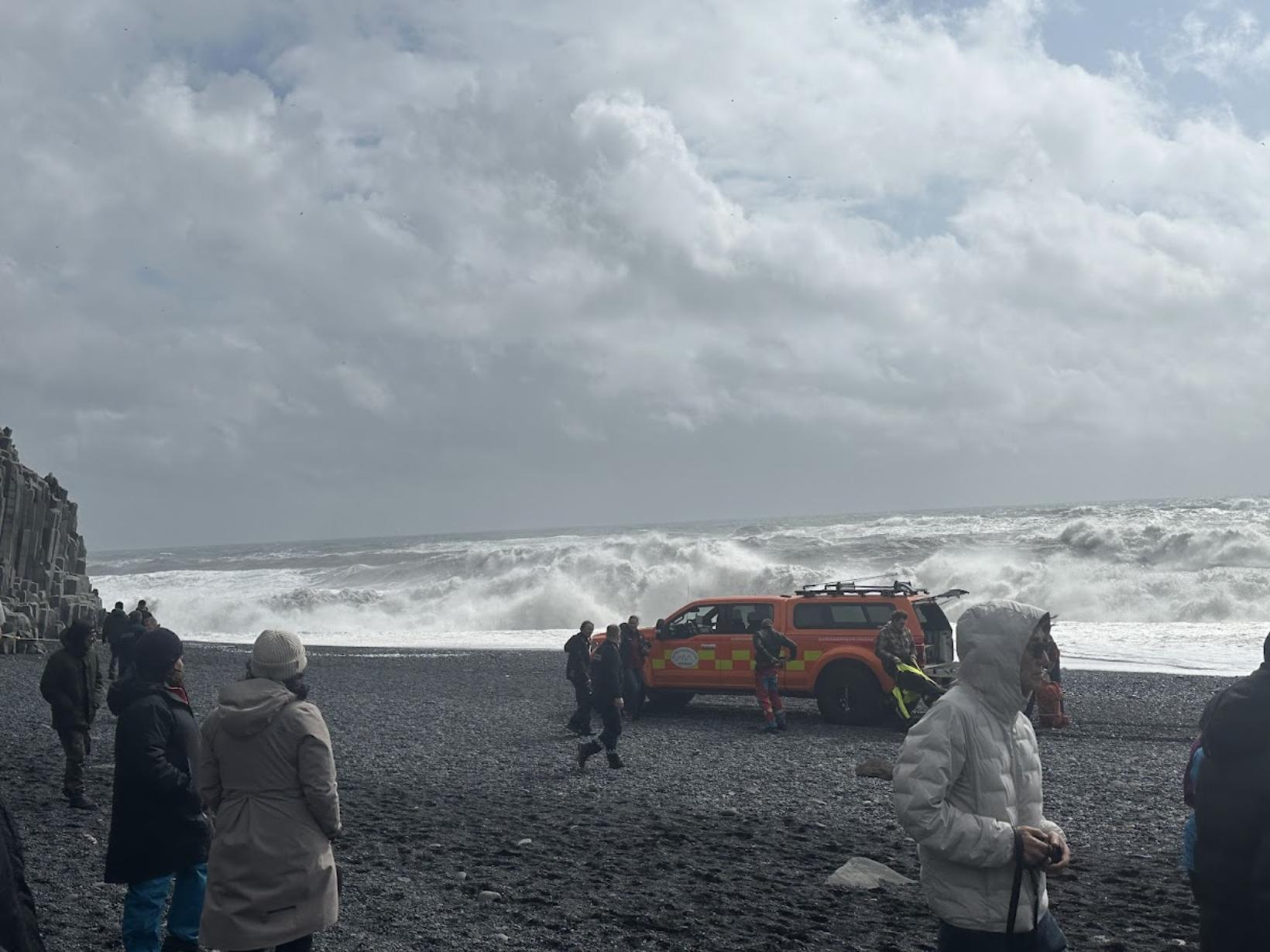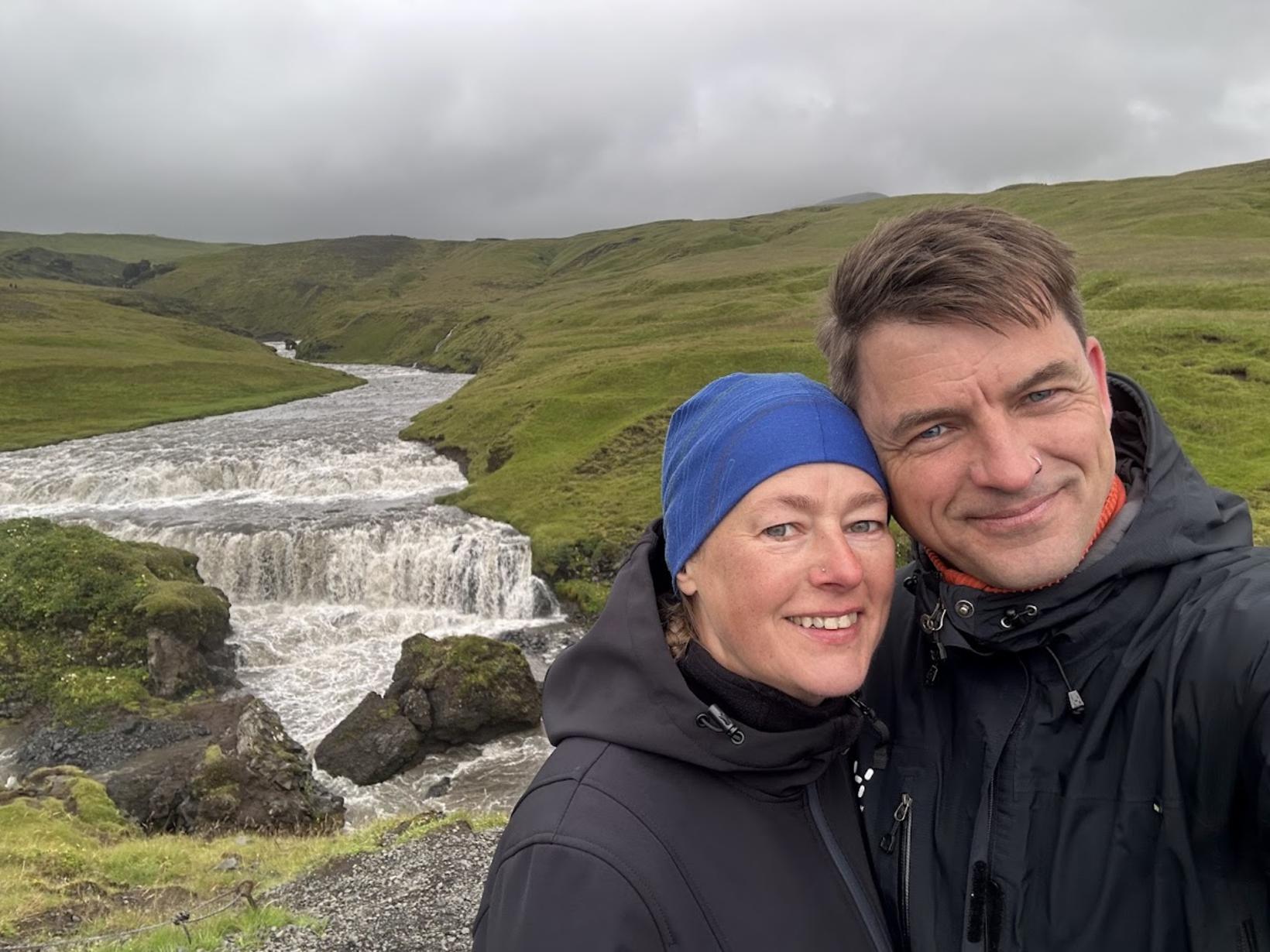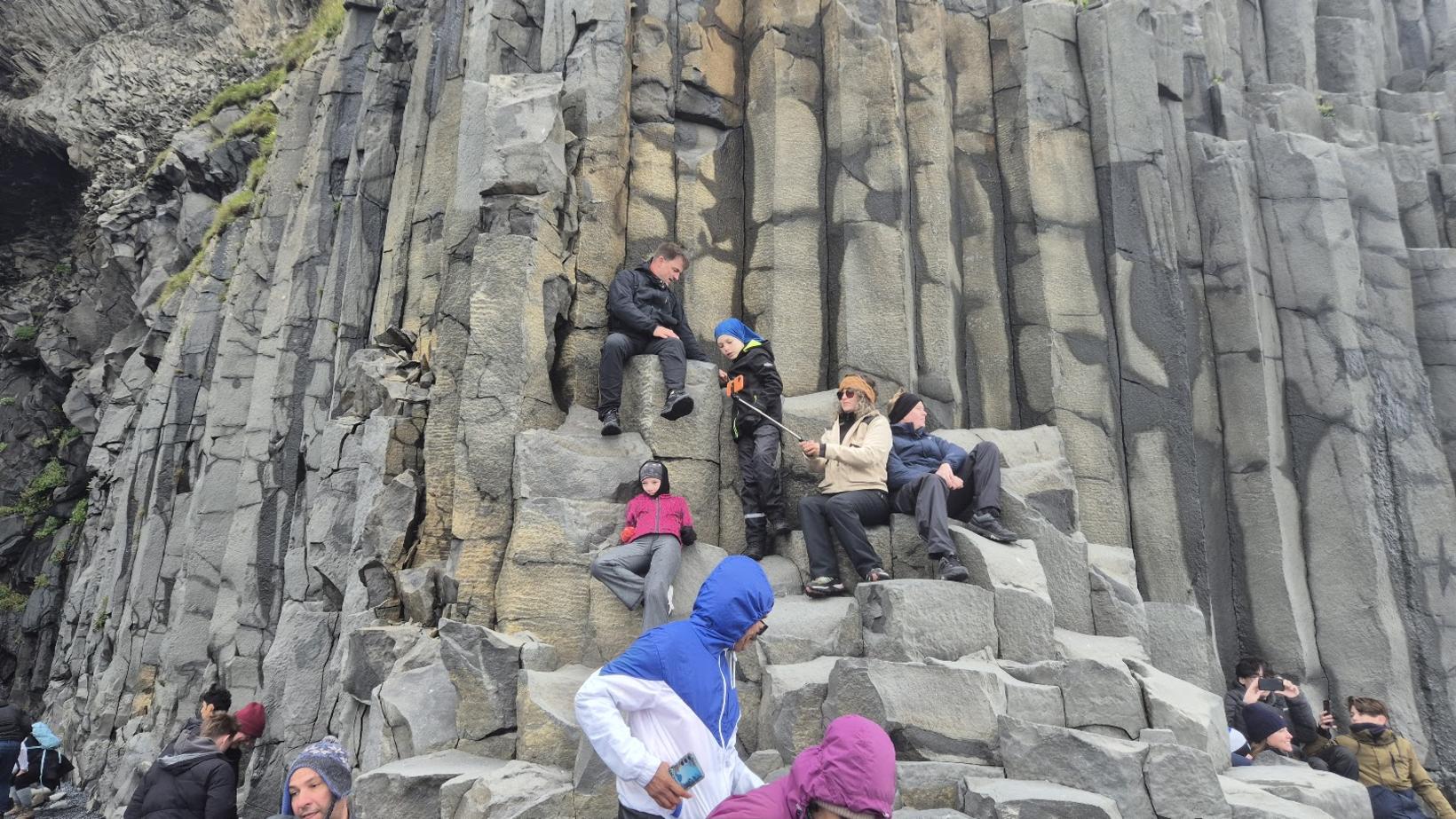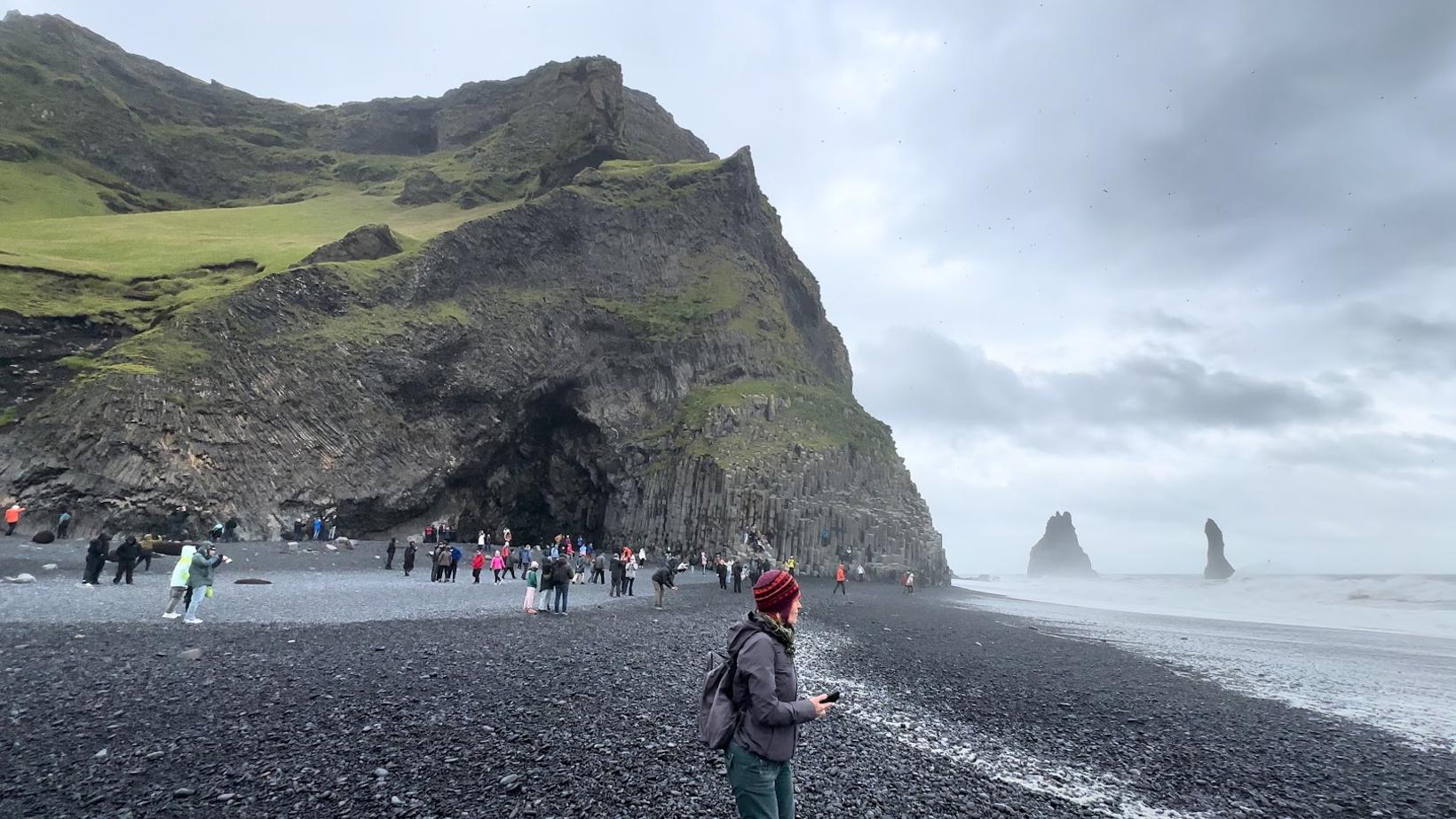Horror at Reynisfjara Black Beach: “We couldn’t help her”
Emergency responders at the scene following the accident. Estonian tourists who witnessed the incident say that visitors are not sufficiently aware of the dangers posed by the beach. Photo/Raiko Suurna
Estonian couple Raiko Suurna and Aivi Murd-Murulauk were on a family trip in Iceland with their children and a family of friends when they witnessed the fatal accident at Reynisfjara Black Beach on Saturday.
A nine-year-old German girl, who was on the beach with her father and sister, died after being swept out to sea by a sneaker wave and the undertow.
In an interview with mbl.is , the couple said that rescue equipment at the site was inadequate and that tourists are far too unaware of the dangers of the area.
They also expressed support for closing off the beach when conditions threaten the lives of visitors.
The couple Aivi Murd-Murulauk and Raiko Suurna spoke to mbl.is about the fatal accident at Reynisfjara. Photo/Raiko Suurna
Two out of eight read the warning sign
“Reynisfjara was one of the last places we decided to visit that day. We parked a bit away from the main parking lot because it was simply full,” says Aivi, adding that around 200 people were on the beach when they arrived and the weather was good.
She says that only two people out of their group of eight read the warning signs.
“The warning was there, but not all of us noticed it – a group of people were standing in front of the sign, so we didn’t see it at first. Two of our group decided to wait their turn to get to the sign and read about the conditions – the others rushed down to the beach since the tide was already coming in.”
After reading about the sneaker waves, which can crash onto unsuspecting people and drag them out to sea, Aivi warned the rest of the group about the danger.
“Some members of our group went to take pictures of the cave that’s farther from the parking lot. The tide had already reached into the cave so they couldn’t enter it, but they climbed along the basalt columns to get closer for pictures.”
Seemed to be trapped in the cave
That’s when they witnessed a wave pulling the child from the cave, on the other side of the basalt formation.
“They seem to have become trapped in the cave — the father and his daughters — and when the wave filled the cave, it took the younger girl with it,” says Aivi.
“I was standing a bit farther away with my child and then saw the twelve-year-old sister running out of the cave, shouting: ‘Please help, save my sister,’ in English. My husband Raiko immediately called the emergency line and started looking for help.”
The family climbed along the basalt column wall to take photos, like many others. Photo/Raiko Suurna
Aivi says that Raiko also walked among other tourists, warning them about the danger.
“He had to tell people to keep a safe distance, because many of the tourists hadn’t noticed the accident and couldn’t hear the family’s screams over the wind and waves. They didn’t realize something terrible had happened and just kept taking pictures and exploring.”
Rescue equipment didn’t suffice
While waiting for emergency services, those present did their best to try to save the girl.
Aivi says someone came running with a life ring and a rescue rope, but the rope was about 10 meters too short to be useful.
“It also didn’t seem particularly strong — it was just several ropes tied together,” says Aivi, adding that the family found it strange how little rescue equipment was available at the site.
“This one life ring and a one-centimeter-thick rope were basically useless,” she says, adding that she believes the rope would have snapped instantly in the rough surf if someone had been holding the other end.
According to the couple, around 200 people were at Reynisfjara when the accident occurred, and most did not realize that the waves had swept the girl out to sea. Photo/Raiko Suurna
“Three or four men had great difficulty pulling the rope back in after it had been thrown out. You can imagine what would’ve happened if someone had been holding onto the other end.”
Tried to run into the surf
After several minutes, the family saw the girl still trying to stay afloat in the waves.
“Her mother and father also saw her and tried to run into the surf to save her. My husband had to hold them back and tried to get someone to run to nearby farms for help.”
Aivi believes that even if the rescue rope at the site had been long enough, it would have snapped in the rough sea during the rescue attempt. Photo/Raiko Suurna
Meanwhile, Aivi tried to comfort the sister at the edge of the beach.
“She was soaked — the wave had hit them all inside the cave — so I gave her my jacket and tried to calm her down. She was completely distraught, screaming her sister’s name over and over, begging us to help her.”
Impossible to help their daughter
Aivi says the nine-year-old girl stayed afloat on the waves for a full twenty minutes. “She was incredibly, incredibly strong, and her mother was showing her how to float while her father ran around looking for help and tried to get out into the waves to reach her.”
But it proved impossible due to the strength of the surf.
“It was horrific. We watched her struggle for half an hour but couldn’t help her. There was nothing we could do.”
The waves continued to rise and the tide kept coming in, according to Aivi, and eventually the girl disappeared from view.
“It was then that the Coast Guard arrived — 30 to 40 minutes after we saw the wave drag the girl away. We got the sister into an ambulance, the helicopter arrived, and we went back to our accommodation.”
The girl disappeared from her family's sight after managing to stay afloat for over 20 minutes. Photo/Raiko Suurna
Tourists unaware of the danger
Aivi says that most tourists were keeping a safe distance from the surf, but not all.
“I think they weren’t fully aware of the danger — we only noticed the sneaker waves after reading the sign, and the large waves seemed so far away that people didn’t realize they could come much closer.”
She describes the sneaker waves as a very unusual phenomenon and believes it’s unlikely that people will recognize the danger on their own if they’re not warned in advance.
“We had only briefly looked at the beach online — it was part of our itinerary,” says Aivi. After reading the sign at the site, they Googled the beach and saw that it was one of the most dangerous in Iceland.
“Still, we had no idea it was dangerous when we went.”
More visible signs and better equipment
The family believes that more frequent and clearly visible warnings could help prevent future tragedies — including closing the beach when necessary.
“People don’t read signs,” says Aivi. “We saw the yellow warning light, but you still don’t fully grasp the danger unless you know what could happen. And we saw it happen.”
She says the rescue equipment was also lacking, and Raiko says he thinks something like a rescue line cannon could have helped.
“Not a harpoon with a sharp tip, but a sturdy and thick rope that could be launched far out to sea and then pulled back,” he says. “Hopefully something like this never happens again, but if it does, such a device could help.”
Ban access instead of just warning
Aivi believes that closing the beach during dangerous conditions would be far more effective than just posting warnings.
“People need to be better informed that this is life-threatening,” she says.
“We knew we were going there at our own risk, but if we had been banned from going because the waves could be fatal, it would never have occurred to us to take that risk.”
Aivi says she believes such bans could make a real difference for visitor safety. “You can’t prevent all accidents, but there’s a lot that can be done to reduce the likelihood of someone losing their life simply because they didn’t know about the danger.”
















